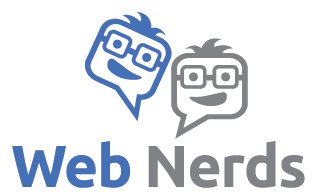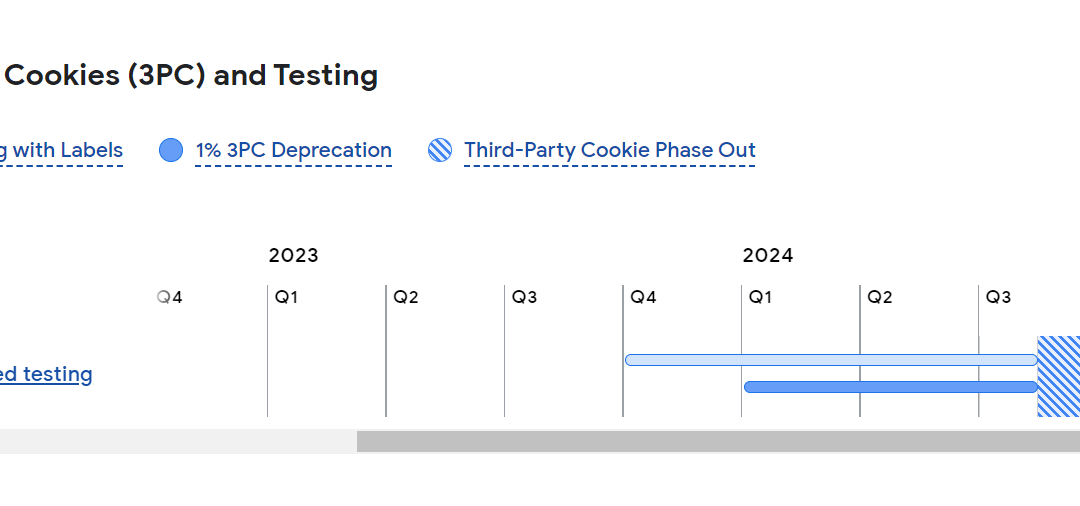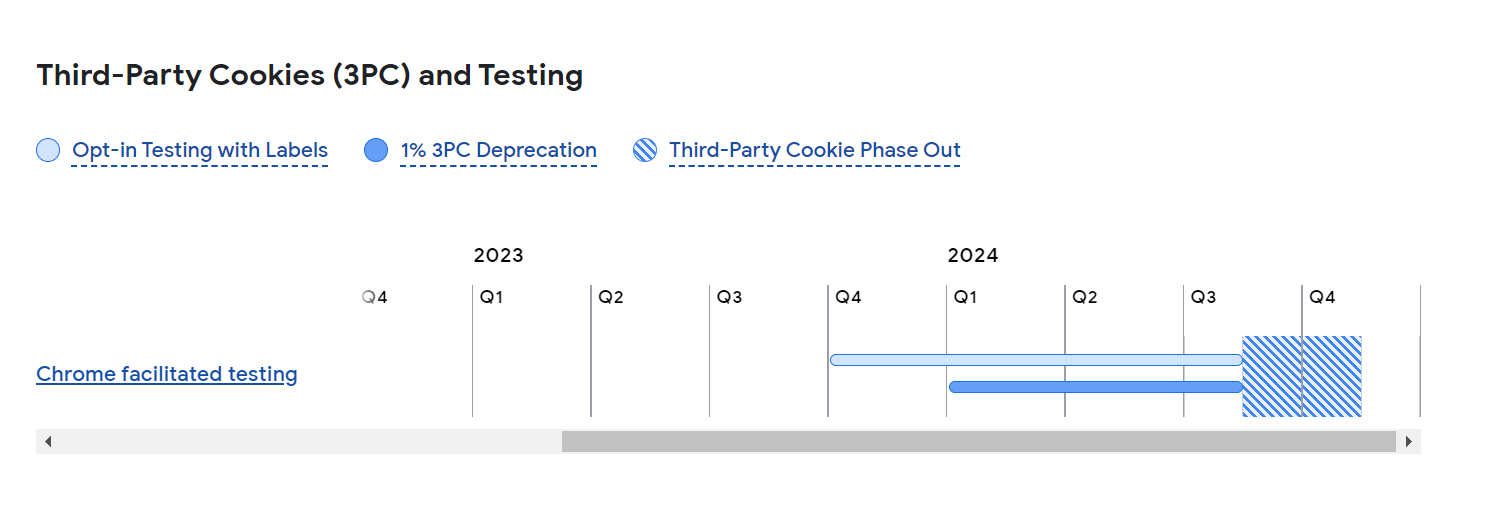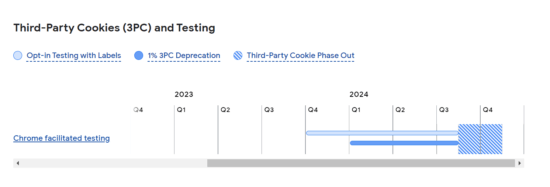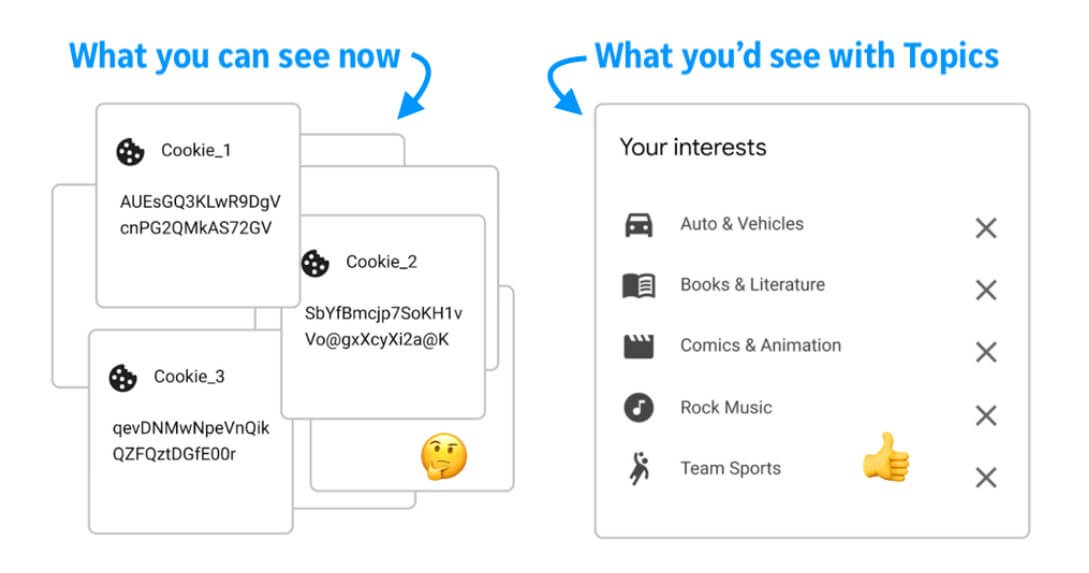How will cookieless advertising work? What actions do businesses need to take to future-proof their advertising plans?
Cookieless advertising: a quiet earthquake?
When Google first announced the deprecation of third-party cookies in Chrome, it quickly became the talk of the town.
The industry press coined a new, ominous word: “cookiepocalypse”. Every other webinar or conference was about this topic – even though, at that point, the consequences were unclear.
Then, Google postponed these changes; not once, but twice. Partly due to feedback they received from the industry around their Privacy Sandbox solutions, partly due to the scrutiny from antitrust authorities (especially in Europe).
Speculations started that Google would just keep on delaying the deprecation, and that the fearsome “cookiepocalypse” would, in fact, never materialize.
Some marketers got complacent. Some were distracted by newer trends, such as Generative AI. Cookieless advertising was no longer considered a hot topic.
Was this wishful thinking? Speaking at DMEXCO in October 2023, Anthony Chavez (VP of Product Management, Privacy Sandbox at Google) gave a clear message: marketers need to get ready for this change, because it’s happening – beginning in January 2024, when third-party cookies will be phased out for 1% of Chrome users.
Yet, there is still a lot of confusion on how to prepare for cookieless advertising. Let’s take a deeper look at how the most common use cases will be impacted.
1. Retargeting
Retargeting means showing a customized ad to users who have visited a specific page or taken a certain action on your website. This is typically a high-performing advertising tactic.
With cookieless advertising, new privacy-friendly tracking techniques will be required to enable retargeting. The main difference is that you will need to implement different solutions for different media platforms – and their approach may vary significantly.
- Google’s Protected Audiences API (formerly known as FLEDGE) will assign users to “interest groups”, defined by an advertiser (or a publisher) based on how they behave on their website. Advertisers can place bids to serve ads to these interest groups on participating publishers. However, the interest groups which a user belongs to will only be stored on their browser.
- On the other hand, the Meta Conversion API, or CAPI (formerly known as Server-Side API), will bypass the user’s device, and send events directly from the advertiser’s website servers to Meta. This means that you will be able to retarget users on Meta based on these events.
- What about the Open Web? Many ad tech providers are building cookieless identity solutions. The leading ones being The Trade Desk (UID 2.0), ID5, and LiveRamp (RampID). These solutions generally rely on hashed email addresses, which limits their usefulness for websites where users browse without being logged in. It remains to be seen which publishers will adopt them, and which ones will build their own identifiers – effectively becoming “walled gardens”.
2. Lookalike audiences
Targeting a lookalike audience means addressing a segment that displays similar interests and behaviours to those of your own website visitors or email subscribers (first-party data).
Like for retargeting, Meta will continue to allow targeting of your website visitors’ lookalikes, providing you have implemented server-side tracking (Meta CAPI).
Everywhere else, lookalike audiences will increasingly rely on hashed email addresses, which makes it even more important to convince users to log-in on your website or subscribe to a newsletter.
Having said that, universal identifiers, such us UID 2.0, generally use a mixture of deterministic data (such as hashed email addresses) and probabilistic data (such as browser version, device type, time zone…) to improve match rate.
If you use DV360 – Google’s DSP – another tool available to you is Google PAIR (Publisher Advertiser Identity Reconciliation). Unlike universal identifiers, PAIR’s encryption keys will be unique to each individual advertiser-publisher relationship. This means that data exchanged between a publisher and an advertiser is only used within that business arrangement.
3. Reaching targeted segments
Leveraging your own first-party data through retargeting and lookalike audiences is the best way to future-proof your advertising strategy in a cookieless world. However, for most advertisers, first-party data doesn’t have sufficient scale to be the only targeting technique they rely upon.
Today, third-party data providers and data management platforms (DMPs) use cookies to track users across partnering websites. Advertisers use this data to create detailed user profiles, understanding their interests, behaviours, and demographics. Programmatic advertising platforms use these profiles to target specific audience segment.
These techniques are being disrupted by the demise of third-party cookies and will soon no longer be available. If you are still spending marketing budget on third-party audiences, it’s time to test different cookieless alternatives from the list below and prepare to reinvest your advertising dollars.
Google Topics API
This project was originally known as FLoC (Federated Learning of Cohorts) and had its fair share of controversy. With the Topics API, Google has moved away from the initial concept of clustering people with similar interests.
Instead, the Topics API labels each participating website with a topic from a pre-defined list (currently there are 469, which means they are fairly broad). Every week, it then assigns one new topic to each user, based on their most frequently browsed ones. Participating sites can then use three topics from users’ recent browsing history to serve targeted ads.
All the data will live on the user’s browser, to maximize privacy and data security. Sites can opt out of being assigned to a topic, and users will be able to review which topics are assigned to them – or opt out of Topics completely. Sensitive topics around race, sexual orientation, religion, etc. will not be included in the list.
Second-party data
This refers to two companies sharing their first-party data with each other, through a partnership or collaboration.
An example of this could be a Grocery e-commerce website partnering with a fitness app, cross-referencing their shoppers’ database with the app’s active users. This may allow the retailer to advertise targeted offers to a new audience segment of Fitness Enthusiasts, based on app users’ shopping behaviours.
Social & Retail media
Social media platforms and retailers have a wealth of first-party data that they can leverage to segment and target users. This will make their ecosystems even more attractive in a world of cookieless advertising.
Retail media is already seeing explosive growth; however, many advertisers see it mainly as a bottom-funnel media channel. If that’s the case in your company, it may be time to also test top-of-funnel campaigns.
Contextual advertising
For many years, programmatic advertising promised advertisers to find their target audience anywhere, using behavioural targeting. With the impending deprecation of third-party cookies, displaying ads next to related content is having a major resurgence.
There are many benefits. Firstly, the context where your ads appear is proven to have an impact on their effectiveness. Secondly, contextual advertising feels a lot less creepy to privacy-conscious users.
4. Frequency capping
Controlling the number of times each user sees an ad is key to limit media wastage. At this stage, cross-site frequency capping is probably the topic related to cookieless advertising with fewer clear answers.
Universal identifiers, like those mentioned earlier, may provide cross-site frequency capping. This will likely be limited to logged-in users – and scale will depend on publisher adoption.
There are a couple of emerging tech solutions that is worth keeping an eye on:
- Google Protected Audiences API will allow frequency capping across sites, but only for campaigns targeting Protected Audiences, and only for impressions served in Chrome browsers and on Android operating systems. This is because the ad auction for interest-based ads will happen in the user’s browser.
- Microsoft PARAKEET is a proposal that works in a slightly different way. Microsoft suggests that the browser should anonymize user identities and pass addressability signals to the auction, which – in this case – would remain with the ad exchange, allowing for cross-site frequency capping.
- While the industry grapples with the issue, chances are that many advertisers will focus on fewer publishers – likely walled gardens – who can relatively easily control ad frequency across their own platform, especially if they have a high proportion of logged-in users.
5. Attribution, reporting & measurement
The deprecation of third-party cookies will deal another blow to multi-touch attribution models (MTA), already impacted by previous privacy updates, like iOS 14. Cookies are also one of the reasons why web analytics have changed. Whilst the topic is too broad to cover in a comprehensive manner in this article, here are a few concepts you need to be aware of.
Google Analytics 4
Google Analytics 4 has been designed to adapt to a future without third-party cookies. Several metrics that were available in previous versions are no longer included, while others require additional configuration. It also includes machine-learning modelling to help fill some of the data gaps.
Google Data-Driven Attribution
Google DDA is a machine-learning model that takes into consideration a wide range of data points to determine which touchpoints are most likely to drive conversions. It then attributes conversion credit based on all these factors, offering an alternative to last-click. The big watch-out: it only analyzes interactions with Google touchpoints (Search, YouTube, Display, Discovery etc).
Marketing Mix Modelling
Many advertisers have already turned to Marketing Mix Modelling (MMM), or econometrics. These are statistical models that don’t rely on any tracking or personal data.
MMM is not new – Consumer Goods giants who rely heavily on TV and other “traditional media” have been using these for ages – however a broader interest in this technique has led to an increase in the number of vendors. Some of these have developed sophisticated tech solutions, which make MMM more affordable and almost real-time.
In conclusion: what should you do now?
The answer will vary depending on your business model, first and second-party data availability, and current media mix.
However, there are a few steps that can be recommended to almost every advertiser who hasn’t already taken them.
- Analyze your current media spend to understand how much you rely on retargeting, lookalikes, and third-party data audiences. This will enable you to prioritize areas that require attention, testing, and reinvestment.
- Invest in first-party data acquisition. Develop online experiences and services worth signing up and logging in for.
- Consider data management capabilities like CDPs (customer data platforms), providing the scale of your business and data justifies the investment – likely multiples of six figures.
- Configure your Google Analytics 4 properly. You will need help from a specialist.
- Consider implementing the Meta CAPI if you are investing significantly in Meta platforms. Engage your technical website team or web agency to implement other relevant APIs.
- Test the relevant Google Privacy Sandbox APIs, such as Topics and Protected Audiences.
- Explore Universal Identifiers such as ID5, UID 2.0, RampID.
- Rethink your attribution model if you are currently relying on a cookie-based solution.
Prior to starting her own business, Elisa worked for P&G UK for a decade, and more recently for Mattel, where she set-up the EMEA Digital & Media department from scratch and launched DTC e-commerce in five European markets.
